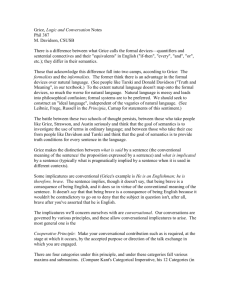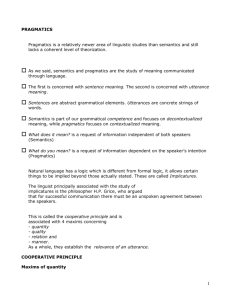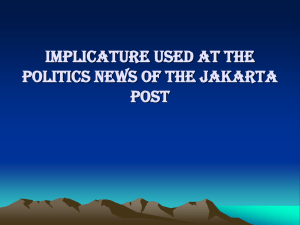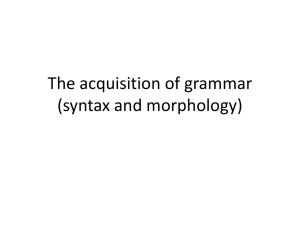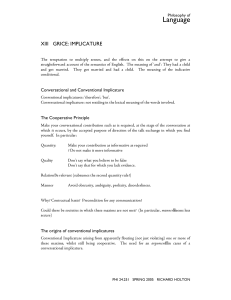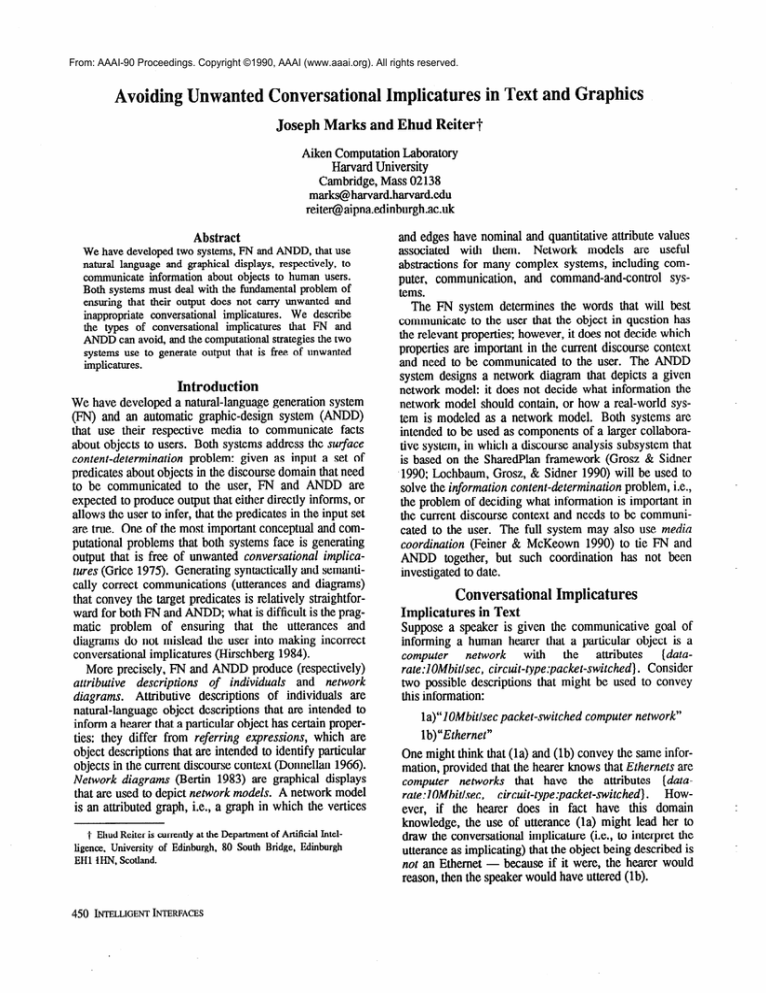
From: AAAI-90 Proceedings. Copyright ©1990, AAAI (www.aaai.org). All rights reserved.
Avoiding Unwanted Conversational Implicatures in Text and Graphics
Joseph Marks and Ehud Reiter”f
Aiken Computation Laboratory
Harvard University
Cambridge, Mass 02138
marks@harvard.harvard.edu
reiter@aipna.edinburgh.ac.uk
Abstract
We have developed two systems, FN and ANDD, that use
natural language and graphical displays, respectively, to
communicate information about objects to human users.
Both systems must deal with the fundamental problem of
ensuring that their output does not carry unwanted and
inappropriate conversational implicatures. We describe
the types of conversational implicatures that FN and
ANDD can avoid, and the computational strategies the two
systems use to generate output that is free of unwanted
implicatures.
Introduction
We have developed a natural-language generation system
(FN) and an automatic graphic-design system (ANDD)
that use their respective media to communicate facts
about objects to users. Both systems address the surJace
content-determination problem: given as input a set of
predicates about objects in the discourse domain that need
to be communicated to the user, FN and ANDD are
expected to produce output that either directly informs, or
allows the user to infer, that the predicates in the input set
are true. One of the most important conceptual and computational problems that both systems face is generating
output that is free of unwanted ConversationaZ implicatures (Grice 1975). Generating syntactically and semantically correct communications (utterances and diagrams)
that convey the target predicates is relatively straightforward for both l?N and ANDD; what is difficult is the pragmatic problem of ensuring that the utterances and
diagrams do not mislead the user into making incorrect
conversational implicatures (Hirschberg 1984).
More precisely, FN and ANDD produce (respectively)
attributive descriptions of individuals and network
diagrams. Attributive descriptions of individuals are
natural-language object descriptions that are intended to
inform a hearer that a particular object has certain properties: they differ from referring expressions, which are
object descriptions that are intended to identify particular
objects in the current discourse context (Donnellan 1966).
Network diagrams (Bertin 1983) are graphical displays
that are used to depict network modeZs. A network model
is an attributed graph, i.e., a graph in which the vertices
t Ehud Reiter is currently at the Department of Artificial Intelligence, University of Edinburgh, 80 South Bridge, Edinburgh
EH 1 1HN, Scotland.
450
INTELLIGENTINTERFACES
and edges have nominal and quantitative attribute values
associated with them. Network models are useful
abstractions for many complex systems, including computer, communication, and command-and-control systems.
The FN system determines the words that will best
communicate to the user that the object in question has
the relevant properties; however, it does not decide which
properties are important in the current discourse context
and need to be communicated to the user. The ANDD
system designs a network diagram that depicts a given
network model: it does not decide what information the
network model should contain, or how a real-world system is modeled as a network model. Both systems are
intended to be used as components of a larger collaborative system, in which a discourse analysis subsystem that
is based on the SharedPlan framework (Grosz & Sidner
1990; Lochbaum, Grosz, & Sidner 1990) will be used to
solve the information content-determination problem, i.e.,
the problem of deciding what information is important in
the current discourse context and needs to be communicated to the user. The full system may also use media
coordination (Feiner & McKeown 1990) to tie FN and
ANDD together, but such coordination has not been
investigated to date.
Conversational Implicatures
Implicatures in Text
Suppose a speaker is given the communicative goal of
informing a human hearer that a particular object is a
[datawith
network
the
attributes
computer
rate:lOMbitlsec, circt.&type:packet-switched)
. Consider
two possible descriptions that might be used to convey
this information:
1a)“lOMbitlsec packet-switched computer network”
1b)“Ethernet”
One might think that (la) and (lb) convey the same information, provided that the hearer knows that Ethernets are
computer networks that have the attributes {datarate:lOMbitlsec,
circuit-type:packet-switched) . However, if the hearer does in fact have this domain
knowledge, the use of utterance (la) might lead her to
draw the conversational implicature (Le., to interpret the
utterance as implicating) that the object being described is
not an Ethernet - because if it were, the hearer would
reason, then the speaker would have uttered (lb).
A similar phenomenon occurs in referring expressions:
consider, for example, the difference between
2a)“Sit by the table”
2b)“Sit by the brown wooden table”
If there was only one visible table (which was brown and
made of wood), then utterances (2a) and (2b) would both
fulfill the referring goal, because a hearer who heard them
would have no trouble picking out the object being
referred to. However, a hearer who heard utterance (2b)
would probably draw the additional conversational implicature that it was somehow important that the table was
brown and made of wood, i.e., that the speaker was trying
to do more than just identify the table. If the speaker did
not have this intention, and only wanted to tell the hearer
where to sit, then the hearer would have drawn an
incorrect conversational implicature.
Implicatures in Graphics
Figure 1 shows a typical network diagram that depicts a
network-model abstraction of a computer-disk system.
The topology of the network model is communicated
directly by the connectivity of the network diagram, and
the nominal and quantitative attributes of the model are
communicated directly by the graphical properties (e.g.,
shape, pen width) of symbols, by text labels, and by
diacritical symbols (e.g., enclosures), as indicated in the
diagram legend.
Given that Figure 1 conveys precisely the desired information, Figures 2 and 3 are variants of Figure 1 that
might be said to carry unwanted conversational implicatures. For example, in Figure 2 the pen-width used in
drawing the channel-facility queue symbol differs from
the pen-width used for all other queue (and server) symbols in the diagram. A viewer of this diagram might conclude that the channel-facility queue is somehow different
from the other queues (and the servers), because otherwise the diagram designer could simply have used the
same pen width to draw the symbol. Other unwanted
conversational implicatures in Figure 2 result from perceptual grouping. For example, the way the disk symbols
are perceptually grouped by proximity to form two ‘gestalts’ might lead the viewer to conclude that there is some
semantic basis to the perceived grouping, because otherwise the designer would not have positioned the disk
symbols in this way. In addition, the layout of the
device-queue symbols violates the Gestalt Principle of
Good Continuation (Kaufman 1974), resulting in the
implicature that one of the device queues is uniquely different, because otherwise the designer could have positioned the symbols as in Figure 1, for example.’ Finally,
in Figure 3 there is an ordering (by size) of the node syml Implicatures that result from perceptual-grouping phenomena
do not occur in chart graphics and maps, because symbol location
in these kinds of graphical display is completely determined by the
display semantics.
bols: this ordering implicates that there must be a similar
ordering relation among the vertices in the network
model, which is not true (given Figure 1).
A thorough analysis that relates these graphical
phenomena to known linguistic phenomena is a topic for
future research. For now, we note that in each instance
described above information is conveyed that differs from
what is communicated directly by the symbols in the
diagram. Furthermore, the ultimate source of implicature
is the assumption that the designer and viewer are following Grice’s Cooperative Principle (Grice 1975) in their
discourse, i.e., that the designer is not trying to mislead
the viewer, and that his design decisions can therefore be
considered as appropriate contributions to the discourse.
Analysis and Discussion
Grice (1975) proposed a number of maxims of conversation that cooperative communicating agents usually obey
(cooperative agents might disobey the maxims to achieve
a particular communicative goal). These maxims fall into
four categories: Quality, Quantity, Relation, and Manner.
We consider how these maxims can be applied to avoid
unwanted conversational implicatures in text and graphics.
Although Grice’s maxims apply to both
information-content determination and surface-content
determination, we will consider here only their application to the surface-content-determination tasks performed
by the FN and ANDD systems.
Quality: Grice’s maxims of Quality require utterances
to be truthful. For our purposes, these maxims translate
into a constraint that everything that is explicitly communicated to the user must be true.
Quantity: The maxims of Quantity require utterances
to be neither more or less informative than is necessary
for the purpose of the exchange. For natural language,
these maxims forbid utterances from containing elements
that are irrelevant, can be inferred from other parts of the
utterance, or are otherwise redundant. For instance, in the
referring expression example of Section 2.1, the adjectives “brown” and “wooden” are unnecessary for
fulfilling the referring goal, and hence their inclusion in
utterance (2b) leads to false implicatures.
The application of Grice’s Quantity maxims to
surface-content determination in graphics is less clear. In
some cases extra information in graphical diagrams leads
to false implicatures: for example, communicating the
same network-model attribute via two distinct graphical
properties (e.g., using both symbol color and shape to
communicate the same information) could lead to
unwanted implicatures, because the viewer might conclude that there must have been some reason the designer
used two graphical properties instead of one. In other
cases, however, extra information is acceptable and even
desirable: for example, if the communicative goal is to
identify the overloaded servers in the disk subsystem, the
network diagram in Figure 1 (which depicts not only the
overloaded servers, but also servers that are not overloaded, various other objects and how they interconnect,
MARKS AND REITER 451
and subsystem affiliation) is preferable to a diagram that
depicts only the two overloaded servers and nothing else.
In yet other cases, the inclusion of ‘redundant’ information may actually be necessary to avoid leading the user
to make unwanted implicatures: for example, the use of
perceptual grouping to reinforce information communicated in other ways is sometimes essential (in Figure 1 the
perceptual groupings of the node symbols reinforce the
subsystem-affiliation information, whereas in Figure 2
they do not), even though the perceptual grouping is in
some sense redundant
Relation: The maxim of Relation requires utterances to
be relevant to the discourse. This maxim primarily
affects the information-content determination task, but it
also has some impact on surface-content determination.
For example, natural-language utterances should not contain irrelevant elements, and graphical displays should
avoid the use of spurious graphical-property values (the
use of a distinct pen-type for the channel-facility queue
symbol in Figure 2 is an example of a spurious or
irrelevant graphical-property value that can lead to an
unwanted conversational implicature.)2
Manner: Grice’s maxims of Manner concern obscurity, ambiguity, brevity, and orderliness. The concept that
probably has the most impact on natural-language generation is brevity: shorter descriptions are preferred over
longer ones, because the use of an unnecessarily long
utterance may implicate that a shorter utterance could not
be used (e.g., the use of utterance (lb) implicates that
utterance (la) could not have been used). The category of
Manner is also important for graphics, but some additional concepts are needed to cover issues that are unique
to graphic design. Two important concepts are appropriate perceptual organization and perceptual limits. To
achieve appropriate perceptual organization spurious perceptual organizations that are orthogonal to the information being conveyed in a diagram should be avoided.
This is necessary to avoid the kinds of unwanted implicatures caused by perceptual grouping and ordering that are
illustrated in Figures 2 and 3. The concept of perceptual
limits also concerns human visual perception: a designer
should limit the number of graphical-property values used
in a diagram so that the values may be easily distinguished, and to ensure that the values are perceptually
dissimilar (well-known design heuristics that concern perceptual limits can be found in (Bertin 1983)).
Basic Level: An additional source of conversational
implicature, which was proposed by Cruse (1977) and
Hirschberg (1985), is the failure to use basic-level classes
(Rosch 1978) in an utterance. For example, consider the
utterances
3a)“I have a red shirt”
2 The use of spuriousgraphical-property
values might altematively be considered a violation of one of the maxims of Manner.
452
INTELLIGENTINTERFACES
3b)“I have a red T-shirt”
3c)“I have a red piece of clothing”
3d)“I have a carmine shirt”
Red and shirt are probably basic-level for most urban
Americans. Accordingly, utterance (3b) carries the
conversational implicature that it is important that the
object is a T-shirt and not some other kind of shirt; utterance (3c) carries the conversational implicature that the
speaker was not able to categorize the object as a shirt or
any other type of commonly used clothing; and utterance
(3d) carries the conversational implicature that it is
relevant that the object is carmine and not some other
shade of red. If none of these implicatures are desired,
then utterance (3a) should be generated.
A similar phenomenon can occur in the design of
graphical displays. For example, a network diagram in
which all the symbols are blinking will likely cause the
viewer to conclude that there is some reason why the
diagram could not be drawn with non-blinking symbols.
Similarly, a network diagram in which all the node symbols are tiny (or huge) will lead to the conclusion that
symbols of ‘normal’ size could not be used. In other
words, some graphical-property values seem to be preferred, and the use of a non-preferred value in a graphical
display may implicate that the preferred value could not
have been used.
The FN System
system (Reiter 199Oa) generates natural-language
descriptions that are attributive descriptions of individuals, i.e., that communicate to the hearer that a particular
object has certain attributes. Utterances (la) and (lb) are
examples of such descriptions. Note that FN does not
generate referring expressions such as (2a) or (2b).] FN
assumes that the user has some domain knowledge, and
takes advantage of this domain knowledge to form better
descriptions. For instance [cf. utterances (la) and (lb)],
if FN wished to inform a user that a certain object is a
computer network that had the attributes (datarate:lOMbitlsec, circuit-type:packet-switched) , and the
object being described is in fact an Ethernet, then FN
would generate (lb) if it believed that the user knew that
Ethemets were networks that had these attributes, and
(la) otherwise.
FN formalizes the problem of avoiding unwanted
conversational implicatures by requiring generated utterances to be maximal elements under a preference finetion. More precisely, let >> be a preference function that
prefers utterances that do not contain unnecessary elements, that use basic-level classes, and so forth. Let D be
the set of utterances that are truthful and that successfully
fulfill the system’s communicative goal (e.g., inform the
hearer that the object is a computer network with the attricircuit-type:packetbutes
(data-rate:lOMbitlsec,
switched)). Then, an utterance in D is said to be free of
false implicatures if it is a maximal element of D with
respect to >>. Hence, an utterance B in D is free of false
The FN
implicatures if there is no utterance A in D, such that A >>
B. The preference-function formalization of conversational implicature is similar to the partially-ordered
sets
that Hirschberg (1984, 1985) used to formalize scalar
implicatures (Gazdar 1979).
FN’s overall preference function consists of three
separate preference rules: No Unnecessary Components,
Lexical Preference, and Local Brevity. We make the
assumption that there are no conflicts between these
preference rules, i.e., that it is never the case that utterance A is preferred over utterance B by one preference
rule, but B is preferred over A by another preference rule.
No Unnecessary Components: The No Unnecessary
Components rule is motivated by Grice’s Quantity
maxim. Formally, it states that A >> B if A uses a subset
of the modifiers (e.g., adjectives, prepositional phrases,
relative clauses) that B uses. Hence, a ‘free-of-falseimplicatures’ description cannot contain any unnecessary
modifiers.
Utterance (2b) is an example of a referring expression
that contains unnecessary components (the adjectives
“brown” and “wooden”) and hence carries false implicatures. An example of an attributive description that contains an unnecessary component is the following:
lc)“packet-switched
Ethernet”
If the user knows that Ethernets
have the attribute
circuit-type:packet-switched,
the
modifier “packetswitched” is redundant, and hence utterance (lb) is preferred over utterance (lc) by the No Unnecessary Components preference rule. Therefore, FN will not generate
utterance (lc) for such a knowledgeable user, since it
might lead her to draw incorrect conversational implicatures (e.g., that there were some Ethernets that did not
have the attribute circuit-type:packet-switched).
Lexical Preference: The Lexical Preference rule is an
extension of the basic-level implicature principle. This
rule assumes there is a lexical preference hierarchy
among the different lexical units that can be used in an
utterance; the lexical-preference hierarchy always marks
basic-level classes as preferred over other lexical units,
and it may include other preference relations as well. The
Lexical Preference rule then states that A >> B if A and B
have the same syntactic and semantic structure, and every
lexical unit used in A is equal to or lexically preferred
over the corresponding lexical unit in B. Thus, free-offalse-implicatures descriptions need to use preferred lexical units whenever possible. An example of Lexical
Preference is that utterance (3a) is preferred over utterances (3b), (3c), and (3d), because (3a) uses basic-level
classes.
Local Brevity: This rule states that it should not be
possible to generate a shorter description by introducing a
single new classification or modifier and then eliminating
old modifiers that are no longer necessary. Formally, say
A
>>> B
if
length(A)
c
length(B),
and
size(components(A)-components(B))
= 1 (i.e. A has
exactly one component not present in B; B can have an
arbitrary number of components not present in A). Then,
>> is defined as the transitive closure of >zs>.FN uses the
number of open-class words as its measure of description
length.
This rule is an approximation to the more powerful rule
of requiring descriptions to be as short as possible. The
latter rule is rejected for complexity-theoretic reasons: it
is impossible to find the shortest description with a
polynomial-time algorithm (Reiter 199Ob). An example
of Local Brevity is that utterance (lb) is preferred over
utterance (la), if the user has appropriate domain
knowledge, because the single class Ethernet in utterance
(lb) replaces both the class computer network, and the
attributes
(data-rate:IOMbitlsec,
circuit-type:packetswitched), in utterance (la).
The generation algorithm used by FN is described in
Reiter (199Oa). The algorithm works by incremental
improvement: it starts with an initial description, and then
repeatedly replaces the current description by a preferred
description, as long as such a description can be found.
The algorithm terminates when it reaches a point where
there are no descriptions that are preferred over the
current one: this means the current description must be
maximal and hence free of false implicatures.
The ANDD System
The ANDD (Automated Network-Diagram Designer)
system automatically designs network diagrams3 Its input
is a network model and a list of relations that describe the
information to be communicated to the user. These relations indicate which attribute values need to be communicated, whether the actual values of the quantitative attributes or just their relative ordering are important, and
which aspects of the network interconnection should be
emphasized (e.g., source-sink paths, feedback loops, hub
structures).
The ANDD system uses an original formulation of syntax and semantics for network diagrams (Marks 1990) to
relate graphical-display symbols to elements and attributes of the network model. This formulation is crucial to
ANDD’s ability to automatically design network
diagrams that are free of unwanted conversational implicatures. It also leads to a natural breakdown of the
overall design problem into distinct design tasks. We first
provide an overview of syntax and semantics, and then
describe the various design tasks, how they are
automated, and the ways in which they try to eliminate
unwanted conversational implicatures.
The Syntax of Network Diagrams: The syntax of network diagrams used by ANDD describes the symbols,
graphical
properties,
and
perceptual-organization
phenomena that a designer can use to communicate infor3 previous research on automating the generation of graphical
displays of data can be found in (FriedelI, Bamett, & Kramlich
1982). (Friedell1984), (Feiner 1985). and (Mackblay 1986).
MARKS AND REITER 453
mation. The morphological elements of network
diagrams are node symbols, link symbols, text labels, and
diacritical symbols. Symbols from each class have their
own set of graphical properties (e.g., node symbols have
the graphical properties of shape, size, pen color, and fill
color). The most novel aspect of the syntax used by
ANDD is the inclusion of relations that describe the perceptual organization of symbols, such as sequential layout
(top-to-bottom or left-to-right), proximity grouping, alignment, symmetry, similarity, and ordering.
The reason for including perceptual grouping and ordering relations in the syntax is that perceptual organization is a property of the human visual system that we cannot disable: it is virtually impossible to design meaningful
network diagrams for which no perceptual organization
will occur. Instead, the ANDD system tries to actively
exploit this property of the visual system (and thereby
satisfy the maxim of Manner) by designing diagrams that
contain appropriate perceptual groupings and orderings
that communicate or emphasize certain information. The
two vertical, evenly spaced node alignments in Figure 4
(designed by ANDD) are an example of this technique:
the node interconnections are clear from the links in the
diagram, but two special paths in the network are visually
emphasized by the active use of perceptual grouping.
The Semantics of Network Diagrams: A major
difference between language and graphics is that
language has a fixed vocabulary (the English lexicon),
while graphics, in general, does not. The meaning of a
graphical property such as shape or color usually changes
from one graphical display to the next; a graphic designer
decides what information is to be communicated by each
graphical property, and uses the diagram legend to inform
the viewer of his design decisions.
In the ANDD system, the semantics of a network
diagram is described in terms of an expressive mapping,
which relates the network-model information to be communicated to a syntactic description of the network
diagram. An expressive mapping includes the obvious
direct mapping from vertices and edges in a network
model to node and link symbols in a network diagram. In
addition, it maps network-model attributes and relations
network-diagram
graphical
properties
and
onto
perceptual-organization relations.
The expressive mapping for the network diagram in
Figure 4 maps vertex names onto text labels, vertex types
onto node-symbol shapes, and edge types onto link pen
types. In addition, node fill intensity is used to visually
emphasize some nodes relative to others (emphasis is one
of the vertex quantitative attributes in the network model).
Finally, relations of sequential layout and alignment are
used to help distinguish the two significant source-to-sink
paths in the network model.
Automating the Design Tasks: ANDD’s syntactic and
semantic formulation leads naturally to two central design
tasks: (i) creating an expressive mapping, and (ii) instantiating a diagram that conforms to the expressive map-
ping*
ANDD uses a rule-based system to construct expressive mappings: the rules encode the conditions under
which the various network-model attributes and relations
should be mapped onto certain graphical properties and
syntactic relations. The rules incorporate a limited
amount of graphic-design expertise to enable the system
to avoid the kind of unwanted conversational implicature
shown in Figure 3: for example, no rule maps a nonquantitative attribute onto a graphical property that will
be perceived as ordered. In addition, the rules avoid violations of the maxims of Quantity (e.g., the use of multiple graphical properties to communicate a single
network-model attribute), and other well-known design
flaws that qualify as violations of the maxims of Manner
(e.g., the use of too many colors, intensities, or shapes).
Once an expressive mapping is created, ANDD
extracts the set of syntactic relations that must appear in
the network diagram to communicate the desired information. It then attempts to instantiate a network diagram in
which exactly these required syntactic relations appear.
The diagram-instantiation task can be thought of as a
constraint-satisfaction problem, in which the constraints
are the required syntactic relations.
The diagram-instantiation task has two subtasks: picking locations for the symbols, and choosing suitable
values for the other graphical properties. The latter task
is performed first, by another rule-based system, which
chooses graphical-property values to satisfy syntactic
relations
governing
the
perceptual-organization
phenomena of similarity and ordering. The various symbol shapes, node fill intensities, and link pen types shown
in Figure 4 were chosen from a palette of graphicalproperty values by these rules. Again, the rules must
encode a certain degree of graphic-design expertise to
avoid unwanted conversational implicatures due to violations of various maxims of Lexical Preference and
Manner, e.g., the inappropriate use of preferred
graphical-property values, or graphical-property values
that are hard to distinguish visually.
Computing diagram layout is computationally much
more difficult. The ideal algorithm for this task would
compute a diagram layout with exactly the required syntactic relations governing such things as proximity grouping, alignment, and symmetry. However,, such an algorithm appears to be computationally prohibitive. As a
reasonable tradeoff between speed and performance (the
eventual context is that of an interactive system), the
current ANDD system uses a third rule-based system that
heuristically picks locations for symbols based on the
desired syntactic constraints and the existing layout of
local regions of the nascent diagram. In principle, this
heuristic approach will not always produce a network
diagram with exactly the desired syntactic characteristics
(and consequent absence of unwanted conversational
implicatures); in practice, the system has worked well in
many cases. We continue to refine our current approach
to the layout task, and to investigate possible alternative
approaches, including the use of mathematicalprogramming and simulated-annealing techniques.
It is interesting to note that FN and ANDD seem to face
similar computational-tractability problems. For both
systems, some of the most obvious formalizations of the
unwanted-conversational-implicature problem (requiring
NL descriptions to be as short as possible; requiring network diagrams to contain certain perceptual organizations) result in computationally intractable solutions. This
has been formally proven for FN (Reiter 199Ob); a formal
complexity-theoretic analysis has not yet been carried out
for ANDD, but it seems likely that such an analysis would
show that the idealized version of the diagraminstantiation task is NP-Hard.
Conclusion
Grice observed that conversational implicatures are not
just a linguistic phenomenon, but that they can occur in
all modes of human communication. People expect communications that are directed towards them to follow certain stylistic/pragmatic rules (e.g., NL descriptions should
not contain irrelevant components; network diagrams
should not contain spurious perceptual groupings), and a
computer system that violates these rules may lead its
users, in an attempt to explain the violations, to draw
unwanted and incorrect implicatures. The task of avoiding unwanted implicatures is central for both the FN
natural-language generation and the ANDD automated
graphic-design systems, and it seems likely that it will be
a fundamental problem for any system that engages in
complex computer-human communication, regardless of
the communication medium.
Acknowledgments
Many thanks to Cecile Balkanski, Mark Friedell, Barbara
Grosz, Julia Hirschberg, Sandeep Kochhar, Candy Sidner,
and Bill Woods for their help. The first author was partially supported by a contract from U S West Advanced
Technologies; the second author was partially supported
by a National Science Foundation Graduate Fellowship,
an IBM Graduate Fellowship, and a contract from U S
West Advanced Technologies. Any opinions, findings,
conclusions, or recommendations are those of the authors
and do not necessarily reflect the views of the National
Science Foundation, IBM, or U S West Advanced Technologies.
References
Bertin, J. 1983. Semiology of Graphics: Diagrams, Networks, Maps. Univ. of Wisconsin Press.
Cruse, D. 1977. The pragmatics of lexical specificity.
Journal of Linguistics 13: 153-164.
Donnellan, K. 1966. “Reference and Definite Description.” Philosophical Review 75281-304.
Feiner, S. 1985. APEX: An Experiment in the Automated
Creation of Pictorial Explanations. IEEE Computer
Graphics and Applications, Nov. 1985, pp. 29-37.
Feiner, S., and McKeown, K. 1990. Generating Coordinated Multimedia Explanations. In Proc. of the Sixth
IEEE Conf. on Artificial Intelligence Applications. Santa
Barbara, CA.
Friedell, M., Barnett, J., and Krarnlich, D. 1982. Contextsensitive, Graphic Presentation of Information. Computer
Graphics l&3:181-188.
Friedell, M. 1984. Automatic Synthesis of Graphical
Object Descriptions. Computer Graphics 18,3:53-62.
Gazdar, G. 1979. Pragmatics: Implicature, Presupposition, and Logical Form, New York: Academic Press.
Grice, H. 1975. Logic and conversation. In Cole, P., and
Morgan, J. eds. Syntax and Semantics: Vol 3, Speech
Acts, pp. 43-58. New York: Academic Press.
Grosz, B., and Sidner, C. 1990. Plans for Discourse. In
Cohen, P., Morgan, J., and Pollack, M. eds. Intentions in
Communication, Cambridge, Mass.: MIT Press. Forthcoming.
Herring, B., and Prather, W. 1986. A simulation model
for analyzing service times in a rotational position sensing
disk system. Simulation 46: 185 19 1.
Hirschberg, J. 1984. Anticipating False Implicatures:
Cooperative Responses in Question-Answer Systems. In
Proc. of the First International Workshop on Expert Database Systems, (2):456-466.
Hirschberg, J. 1985. A Theory of Scalar Implicature.
Ph.D. diss., Report MS-CIS-85-56, LINC LAB 21, Dept.
of Computer and Information Science, Univ. of Pennsylvania.
Kaufman, L. 1974. Sight and Mind: An Introduction to
Visual Perception, New York: Oxford University Press.
Lochbaum, K., Grosz, B., and Sidner, C., Models of Plans
to Support Communication: an Initial Report. In Proc. of
AAAI- 1990, Boston, MA.
Ma&inlay, J. 1986. Automating the Design of Graphical
Presentations of Relational Information. ACM Transactions on Graphics 5: 110-14 1.
Marks, J. 1990. Automating the Design of Network
Diagrams, Technical Report, TR 02-90, Center for
Research in Computing Technology, Harvard Univ.
Reiter, E. 1990a. Generating Descriptions that Exploit a
User’s Domain Knowledge. In Dale, R., Mellish, C., and
Zock, M. eds. Current Research in Natural Language
Generation. London: Academic Press. Forthcoming.
Reiter, E. 1990b. The Computational Complexity of
Conversational Implicature. In Proc. of the 28th Annual
Meeting of the Association for Computational Linguistics. Forthcoming.
Rosch, E. 1978. Principles of Categorization. In Rosch,
E., and Lloyd, B. eds. Cognition and Categorization, pp.
27-48. Hillsdale, NJ: Lawrence Erlbaum.
Sanden, B. 1989. An Entity-Life Modeling Approach to
the Design of Concurrent Software. CACM 32:330-343.
MARKS ANDFUTER
455
Figure 3 Another variation
of Figure 1.
Figure 1 The disk subsystem of a computer
[after Herring & Prather (1986)).
;1;1*4j
:..._‘.“‘__~~‘_~.._~..~.~~.~~~~~-
:........
-.___.__.__.___._._.__._..______
.-.....-.......
.
.
.
.
.
.
.
.
.
.
..-.-
.
.
.
.
.
.
.
.
.
.
.
.
.
.
.
.
.
Figure 2 A variation
.
.
.
.
.
of Figure
Figure 4 A network diagram designed by ANDD
[after Sanden (1989), p.3371.
456 INTELLIGENTINTERFACES



